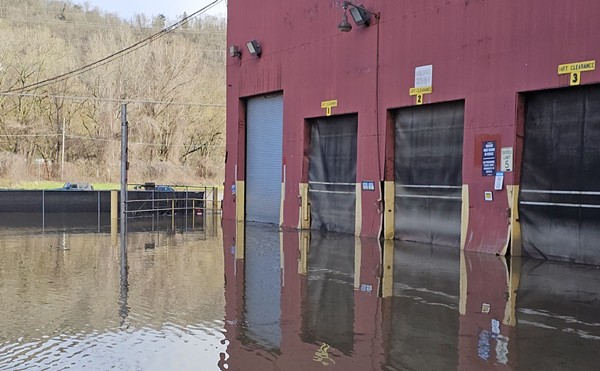Ickes called the fire department, which reported getting calls, but wasn't sure what the problem was. The dispatcher asked if she wanted to go to the hospital. Ickes said no; she didn't have insurance.
The next morning, she awoke to find her eyes crusted shut, her tongue white, her lips burned. Her throat felt as if she'd been popping jalapeños all morning; she could hardly swallow. She gasped for breath, then drove herself to the emergency room, where they measured the level of oxygen in her blood and discovered it had dropped to 52 percent -- so low that they worried her organs would shut down. She was on oxygen for 12 hours.
Ickes's life changed that night. She was a spry 40. Now she has asthma, diabetes, and fibromyalgia, a painful muscle disorder. She used to coach baseball and play soccer with her kids. Now she wheezes, her inhaler constantly at her side. She's on five different medications, and she's been to the emergency room three times since that night. She owes about $5,000 in medical bills. Too exhausted and achy to work, she's about to lose her relaxation therapy business and her house.
It's hard to state definitively what happened that evening. What is undisputed is that the Nylonge Corporation, a sponge manufacturer six blocks from Ickes's home, accidentally released 24 pounds of hydrogen sulfide around 8:30 p.m. The chemical irritates the mucus membranes and can cause respiratory and neurological problems, says Seline Chou of the Agency for Toxic Substances and Disease Registry.
At least five residents experienced breathing difficulties and called the fire department or LifeCare that night. But Nylonge didn't notify anyone until seven hours after the release, because it was unaware of the problem, says company attorney Steven D. Bell. By law, Nylonge doesn't have to report releases of less than 100 pounds, even though the 24-pound release was 12 times its normal hourly limit.
Bell insists there is "absolutely" no connection between the release and Ickes's disorders. He doesn't deny that hydrogen sulfide can cause problems, but says there simply wasn't enough released that night to hurt anyone.
Ickes disagrees. Her doctor declined to discuss her condition with Scene, saying he may be summoned for upcoming litigation. But Ickes says the doctor gave her a terse directive following his examination. "'You go home today and put a "for sale" sign in your yard,'" she repeats, her voice still raspy and labored. She pauses, her eyes distant. On the kitchen table in front of her are medication bottles and inhalers. "But who's going to buy this house now?"
A medical assistant and former military wife, Ickes moved from Omaha to Elyria four years after her divorce to be close to her mother. She never planned to be the poster child for a neighborhood battling to rid itself of a sponge plant. "I've been all over the world, and this is the worst," Ickes says. Then she coughs.
The neighborhood doesn't look dangerous. The quiet streets off Lake Avenue are lined with small postwar ranches and large oaks. Residents aren't wealthy, but most own their homes and maintain them meticulously.
Despite its proximity, the Nylonge plant can't be seen in the neighborhood, except from West Park. Only there, past the soccer goals and telephone poles, are two thin spires visible. Little puffs of steam rise from the top, but the effect is much less forbidding than the traditional smokestack of, say, the Moen factory down the street.
Nylonge came to Elyria in 1991 after 40 years on West 70th Street in Cleveland. The company, then called Sponge Incorporated, wanted to expand, but had run out of room. So the Ohio Department of Development issued $8.4 million in low-interest loans to build a sprawling new factory off Elyria's Lowell Street, near the railroad line that feeds the city's industrial district.
Elyria was eager to land the plant. It offered Nylonge a tax break that began at 100 percent in 1991 and gradually dropped to 50 percent over 10 years. The company's average tax savings in that decade was a whopping 82 percent, according to Elyria's community development department. "The city welcomed it," Bell says.
Neighbors did not. Residents thought Nylonge stank. The rotten-egg smell of sulfur wasn't always present, but when it was, it could be brutal. "After Nylonge came, we could not enjoy being outside," says longtime resident Jean Britton.
Some people got central air for the first time. The ones who already had it cranked it up. "We turn it on from early in the summer to late October," says Nodga Webb. "You can never go outside because of the smells." Others, like Brenda Palazzi, noticed a thin white powder covering windows that faced the factory. Their cars had the same dusting.
A few neighbors suspected more serious problems. Sandee Bohrer and her husband Donald had lived on Lowell Street for 21 years when Nylonge built its cream and burgundy plant practically in their backyard. Bohrer says she noticed a terrible stench immediately.
The Bohrers lived with the smell for three years, annoyed but helpless. They sold their above-ground swimming pool, because the yard stank too much to use it, but they didn't want to move. They liked the neighborhood and had invested too much in the house to leave. "That's where we wanted to be forever," Sandee Bohrer says.
The couple was counting down to 1996, when Donald could retire from General Motors with full benefits. Instead, in 1994, their lives fell apart. Sandee got pneumonia in April. Then Donald got it in October. "He was not a hospital person," she says. "He'd never been sick." But his pneumonia went straight into emphysema. His doctor diagnosed him with chronic obstructive pulmonary disease, a progressive illness that starts with a cough and can end in death. Though two years from retirement, he never returned to GM.
By Thanksgiving, Sandee was back in the hospital, again with pneumonia. She, too, was diagnosed with chronic obstructive pulmonary disease, and both she and her husband developed diabetes, probably as a result of the breathing steroids they were on, she says. She had to hire nurses to care for Donald.
Their doctor told them the cause was probably environmental. "He told us we'd either need to move or we'd be dead," Sandee says. They moved to a smaller house in Lorain, but the damage was done. On May 9, 1997, Donald Bohrer died.
Sandee tries not to be bitter, but she can't help it. Her health is so erratic that she had to quit volunteering at a rape crisis center. She misses her old neighborhood and the money she could have gotten from Donald's full retirement. Most of all, she misses her husband.
Bohrer is convinced that Nylonge triggered the illnesses. Scientists, including those at the Environmental Protection Agency, say air pollution can exacerbate asthma and pneumonia.
Still, Bohrer knows the arguments against her theory are also strong -- the couple smoked, and there are numerous other industries in the neighborhood, including the Aztec chemical company, which actually blew up in 1993. It doesn't help that, a few years after the move, she lost the couple's medical records in a basement flood.
But she still believes. "Some things you just can't chalk up to coincidence," she says. "I lived with that smell. I know what it did."
She also knows what happened to her little cockatiel, Toby. In July 1994, after Sandee Bohrer's first attack of pneumonia and just before her husband's, Toby became ill. The veterinarian diagnosed him with pneumonia too, she says. He died that same night.
Bohrer called everyone she could think of, including the Ohio Environmental Protection Agency and the City of Elyria. After her husband died, she called lawyers and newspapers. No one wanted to touch her story. After a while, she just gave up.
But Pauline Leboda never gives up on anything. A native West Virginian with rapid-fire speech and deceptively guileless blue eyes, she boasts of being descended from the infamous Hatfield clan, of the Hatfields and McCoys. "They're wonderful people, but you don't step on their toes," she says. "I don't have enough sense to be afraid. I just keep praying until God tells how to get 'em."
Leboda arrived in Elyria when she was 19; she moved to the modest neighborhood off Lake Avenue four decades later, two years before Nylonge arrived.
After a lifetime of good health, Leboda became plagued with a series of unusual illnesses. In 1991, around the time the plant opened, she developed severe chest pains. In 1992, doctors found lesions on her liver. She woke up one morning in 1993 paralyzed. "I couldn't move for about two hours," she says. When her grandchildren visited, she noticed that they complained of headaches. Several times, they ended up vomiting and getting diarrhea.
When Leboda's doctor suggested the problems might be caused by toxins in her neighborhood, she called the Ohio EPA for information. She didn't get far and might have let it go, but for an unsuccessful city council bid in 1997. During the campaign, she went door-to-door in the neighborhood, surveying residents about their concerns. Their answers surprised her in their simplicity: "Everyone in the whole area said, 'Please help us, this company is killing us.'"
So Leboda did more research. Eventually, she found Teresa Mills, director of the Buckeye Environmental Network, who had gotten the U.S. EPA to shut down a plant in her Columbus neighborhood in 1994. Mills taught her how to research pollutants.
What the women found shocked them. Nylonge had released more than 100 tons of volatile organic compounds each year: 195 tons in 1992, 158 in 1993, 112 in 1994. The bulk of these consisted of carbon disulfide, a highly flammable compound that can cause dizziness, headaches, and nose and eye irritation. Over long periods, exposure can cause permanent damage to the nervous system, according to the U.S. EPA. Mixed with other chemicals, it can also increase smog.
Lorain County already had ozone problems before Nylonge's arrival, so the company was barred from releasing more than 99.4 tons of carbon disulfide per year -- a limitation it hadn't had in Cleveland. But by the time Leboda obtained the records in 1997, the company had exceeded that limit in each year of operation. It had never been fined or even cited.
The Ohio EPA was aware of the company's illegal emissions, according to its files. The U.S. EPA notified the state agency in 1990 about the strict limits, and the Ohio EPA notified the company in writing two weeks later.
Still, it let the company operate for five years with only a preliminary permit. The Ohio EPA knew Nylonge couldn't meet the strict release limits contained in a five-year permit, Donald Schregardus, the agency's director, wrote in a 1997 letter to Leboda. "Ohio EPA did not issue a permit to operate because such an issuance would indicate that the facility had demonstrated compliance with air pollution control standards and had met all conditions of the permit to install. Because Ohio EPA did not believe these requirements had been demonstrated, the issuance of a permit to operate would have been inappropriate and not protective of human health and the environment."
The agency never explained how allowing the company to operate without a permit protected the environment. And even after Nylonge obtained its permit in 1995, the company still exceeded the emissions. The Ohio EPA took no disciplinary action. (Nor did it respond to interview requests from Scene.)
Leboda called the U.S. EPA, which launched an investigation. In January 1999, it cited Nylonge for operating without a proper permit from 1990 to 1995 and exceeding the permit in 1995. The agency fined Nylonge $104,250, though it later reduced the sum to $17,812, with a mandate that Nylonge spend $65,074 on technology to cut air pollution. Leboda ridiculed the sum as too little, too late.
The City of Elyria also went after the company. In January 1997, it sued Nylonge for releasing carbon disulfide gas into the sewer system. The city claimed the chemical seriously damaged the system's structure. The company insisted that design flaws were to blame and refused to settle. A jury eventually awarded the city $1.3 million. (Subsequent negotiations reduced the amount to $650,000.)
Some activists might have stopped after that, but Leboda continued to hammer at Nylonge any way she could. She ran unsuccessfully for mayor in 1999, criticizing Nylonge all the way, and formed a group called Lorain County Neighbors Protecting Our Environment.
With Leboda at the helm, the group pestered politicians, the EPA, and a host of other agencies in the government's alphabet soup. It got the U.S. EPA to call in the Department of Labor's Occupational Safety and Health Administration, which slapped the company with $1,400 in fines. When the company was late with a set of mandated tests, Leboda filed a complaint forcing the Ohio EPA to investigate. When she got a tip that Nylonge was putting hazardous waste in its trash bin, she called authorities. (They found nothing to substantiate the claim.)
Leboda's tenacious tactics rallied the neighborhood and annoyed the company. Her sensationalist fliers, distributed to round up residents for meetings and protests, even earned a "cease and desist" letter from Nylonge. Bell, the company's lawyer, believes Leboda has crossed the line several times into outright libel. "We absolutely could sue," he says, though he'd be surprised if the company did.
Concerned about increasing complaints, the city and the Ohio EPA hosted a meeting in February to discuss the situation.
Ohio EPA Manager Dennis Bush said his agency was getting an "unacceptable" number of odor complaints from neighbors. "We're prepared to issue a violation of the odor nuisance rule," he said. Spokeswoman Kara Allison told The Elyria Chronicle-Telegram earlier that week that the agency was also considering sanctions against Nylonge for its failure to submit a complete risk-management plan.
But if the EPA thought its announcements would soothe Leboda's group, it had underestimated the anger. Even before Bush spoke, Leboda stood up and shouted that they had heard enough.
"We're here for one reason tonight," she said. "We don't want to hear one thing the EPA has to say. We know what they do. They do nothing. We want to know: Are you going to help us put this company out of Elyria? That's what I want to know. Because if you aren't, then I'm leaving." A few Nylonge workers, their mullets tucked under baseball caps, cheered as Leboda and 30 supporters marched out.
Bell wasn't cheering. "For 11 years, we've been waiting for one of these people, just one of them, to tell us what the real problem is," he told the remaining crowd, his face angry. "The answer is, there is nothing wrong with this plant."
Bell believes the real problem is Leboda. The company has been in compliance with clean-air laws since 1996. It also introduced a biological "scrubber" to digest toxic chemicals. Rather than release chemicals into the air, the company feeds them to colonies of microorganisms, which convert them into safe carbon dioxide. Bell is proud of the company's efforts and eager to talk about them with the neighbors.
"Unfortunately," he says, "it's not easy to do that, when they don't attend meetings or walk out of the meetings they do attend. We've attempted to have a serious conversation about these issues, and it wound up being a one-sided forum."
After Leboda and her friends left the February meeting, Nylonge employees dominated the discussion, singing the company's praises and blasting Leboda for trying to drive them out of town. In Elyria, where good union jobs are sacred, the argument carries weight.
"The company is happy to discuss the issues, work through those issues, and continue making efforts to be the best neighbor it can be," Bell says. "But if the only way to do that is to shut down the plant and put 200 people out of work, how do you be a good neighbor?"
Bell believes Leboda's rage is not only damaging, but ineffective. In the early 1990s, he represented a Newburgh Heights group fighting a dump contaminated with radioactive waste. In 1994, the Chemetron Corporation, which owned the dump, agreed to pay the group $5 million.
The key was a scientific study that showed the health risks in the neighborhood, Bell says. It gave the group power to get the site cleaned up and get enough money to move out. "The difference between that and the people next to Nylonge is that they are unable to prove there is a health risk. In fact, all the scientific evidence refutes the contention that there is a risk."
Nylonge employees are healthy, he argues, and the maladies that residents complain of don't necessarily correspond to risks associated with carbon disulfide. Even past transgressions didn't endanger the neighborhood, Bell says. "I think it is unscientific, to the point of being reckless, to say that any permit violation in the past was of such a nature that it exposed anyone to a harmful level of anything," he says.
He also disputes complaints about the hydrogen sulfide release August 14. He's seen the list of calls to the fire department and LifeCare, but he isn't convinced. "One person called a bunch of neighbors and said, 'Go outside and smell,'" he says. "What went out in August is no greater than what there is on any given workday." Today, Nylonge is in compliance with air-emission rules.
Leboda and Mills say that means little, since compliance tests are only required every four years. "They can be operating out of compliance for hundreds of days, as long as they meet it once in four years," Mills says. Also, the company's permit has a "nuisance" component. "If the neighborhood is complaining, they are not in compliance."
Juliann Shirk has four children and, at the moment, one foster child. She's hoping to get two or three more. Her husband lost his tool-and-die job when York International closed its Elyria factory, and times are tough.
Shirk worries about Nylonge. "I watch the kids who come to stay with us," she says. "I see what's going on. They don't have headaches before -- they get them when they come here." She also wonders about her own headaches and the fact that she's in full-blown menopause at age 41. The Environmental Defense Fund puts Nylonge in the top 10 percent of facilities nationwide that release airborne toxins damaging to development and reproduction.
Shirk regrets ever coming to western Elyria. "We've been here 14 years. Every day, I'm sorry we bought this home."
She's not alone. Many of her neighbors are convinced Nylonge's emissions are ruining their health, but they can't afford to move. "The place is a real trap for people," says Glenn Landers, an air pollution specialist for the Sierra Club. "They move there because they don't have a lot of money. And once they get there, the facilities increase the pollution, and things get worse. If the companies are destroying their property values, then they're really trapped."
Amy Averitt's two-year-old son, Tyler, has enlarged lymph nodes, asthma, and frequent bouts of bronchitis. Although she lives a mile from Nylonge, she's a single mother, and her son is usually at her mother's house a few blocks from the plant. "Our bodies can tolerate more, but he's been really, really sick," she says. She can't take Tyler to the emergency room often, because she doesn't have insurance. Most of the time, she just does what she can. "He's just starting to talk, so he'll say, 'This hurts' or 'That hurts,' and it's hard to watch."
Asthma is the most frequent complaint. Fourteen-year-old Dudley Ross, who lives with his grandmother on Lowell Street, has spent much of his life in and out of the hospital, surrounded by breathing machines, medicine, and inhalers. "You're supposed to outgrow asthma, but he hasn't," says Jewell Ross, his grandmother. For the first time in his life, Dudley received doctor's clearance to run track this spring, but he can't run in his own neighborhood without checking the air first, Ross says. The family is convinced that the smell triggers his attacks.
Cassie Hale, Averitt's sister-in-law, has three kids of her own with breathing problems and easily rattles off a half-dozen neighbors with the same problem. "It's all over here," she says. "If I could move, I would." Like Shirk, she gets horrific headaches.
Children and seniors seem to be affected the most. Betty Weigl's elderly husband died last year after getting seizures so bad, he couldn't breathe, she says. He was on a ventilator for a year, and he spent his final months spitting phlegm into a trash can. "I never attributed it to the plant, but as time goes on, I think of the smell coming in, and I don't know what else to say," she says.
Other conditions are more rare. Brenda Palazzi's 24-year-old daughter was recently diagnosed with polymyositis, a neuromuscular disease. Robin Plas's son developed vitiligo at age 12, losing pigment in his hands and face after spending summers playing in the woods behind Nylonge. He developed diabetes soon after, and his best friend was diagnosed with it six months later. "That makes me wonder, because it's genetic, but something has to trigger it," Plas says.
The hydrogen sulfide release August 14 only increased neighborhood worries. Chou, of the Agency for Toxic Substances, says the chemical starts causing problems at about 10 parts per million, and while it's unlikely the release reached this threshold, she says it's not impossible. At that level, the chemical causes irritation, burning, and headaches, although its effects vary with individual sensitivities, Chou says.
No one else seems to have been affected to the extent that Ickes has, but many say they found themselves retching or gasping. Shirk's foster son broke out in hives, she says. Rita Hale says her tongue turned white. She called her daughter, Averitt, and both Averitt and her son discovered that their tongues were also white, "like if we'd eaten powdered sugar," Averitt says.
People with trouble breathing had the most problems. Jessie Jackson needed to use her oxygen machine, as did Webb. "When you gasp for breath like that -- my voice was practically gone," Webb says. "Until you get into a situation like that, where you don't know if your last breath is coming, you just don't know how bad it is."
Some didn't wait for city officials to act -- they evacuated themselves. Ila Hudson often notices her eyes and nose burning during heavy-odor times, so that night, she went to a friend's home. Weigl stayed overnight with her sister-in-law in Sheffield Lake. "You've gotta use common sense," she says. "No one's going to knock on your door and tell you what to do."
The neighbors became so vocal in the following months that the Elyria Health Department called its state counterparts and asked them to do a health study, says Kristopher Weiss, a spokesman for the Ohio Department of Health. Robert Indian, the state's chief of community assessments, agreed, and plans to meet with neighbors this spring, Weiss says. Elyria Health Commissioner Kathryn Boylan did not return repeated calls for comment.
It won't be Elyria's first study. A research team from the federal Agency for Toxic Substances came to Elyria in 1998 and attempted to document chemical levels around Nylonge during smelly periods. They found little evidence of hydrogen sulfide exposure, but wide fluctuation when it came to carbon disulfide: from extremely low concentrations most of the time to about 290 parts per billion at one point -- a level close to the agency's minimum risk level.
But, says Greg Zarus, the atmospheric scientist who performed the study, the amount of carbon disulfide would have to reach that point every minute of every day for a year to rise to a level where the agency believes it could cause health problems. "You can take two aspirin a day for 50 days, and you'll be fine," he says. "You just can't take one hundred in a day or you'll die." Zarus concluded there was no serious risk and closed his study without recommending future research.
Yet Zarus says he can't conclude that the neighborhood is safe. Carbon disulfide hasn't been conclusively tested for its effect on the respiratory system, he says. "The research is lacking. We know asthma, for example, is rising, and that environmental factors exacerbate it. But the only things we've studied are things that are more common -- dust and the ozone."
New tests of hydrogen sulfide, for example, show some evidence that it triggers breathing difficulties, Zarus says. But carbon disulfide remains a mystery. "We just don't know."
Its effect on the nose is another story. "I wouldn't want to buy a new house in that neighborhood," Zarus admits. Many states and cities have enacted tougher laws limiting its use for that reason. Ohio and Elyria are not among them.
Ickes isn't waiting for another study. She's hired Avon Lake attorney Richard D. McClure, who is investigating the connection between her health and Nylonge's release.
"I want to leave the area," Ickes says. "I'm not financially able to do that now. If I file this lawsuit, maybe I can." Based on what her doctors tell her, Ickes believes she will continue to have painful relapses until she leaves. But even as she puts up her "for sale" sign, Ickes wonders about her neighbors. "This whole area is suffering."
Many in the neighborhood have decided they won't be happy until Nylonge is gone. Absent that, they want the company to buy the neighborhood out. They no longer believe the two can live side-by-side.
It's a hard conclusion in an area that prizes good jobs over practically everything else. But their fight has made them distrustful, says Sarah Cherven, a resident of 23 years. "We're not about trying to shut people down," she says. "If you can make this stuff and not pollute our sewage and our air, you can stay. But they can't do that. I do not believe them whatsoever. As long as I can go out into my backyard and get nauseous in 30 seconds, I don't believe them."
Mills understands the community's anger. She's seen it before. "No one starts out saying, 'This needs to be shut down,'" she says. "It's the frustration and the lies. They start to see no other alternative, because they don't think the company will ever be in compliance 24 hours a day, seven days a week. They've seen too much."
The Ohio EPA slapped Nylonge with an odor nuisance citation February 20, but it didn't include a monetary fine. Nylonge continues to believe the increase in complaints is the result of a conscious neighborhood campaign to hurt the plant, but Bell says the company will examine the agency's list of ways to minimize odor.
Many in the neighborhood don't seem to care. They see the government's enforcement efforts to date as lame appeasement. Nodga Webb just laughs when a reporter asks if she's happy about the citation. "I'd like it more if they moved out of here."













